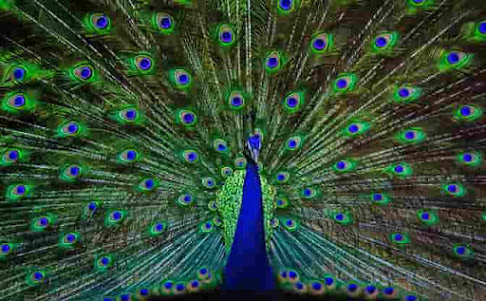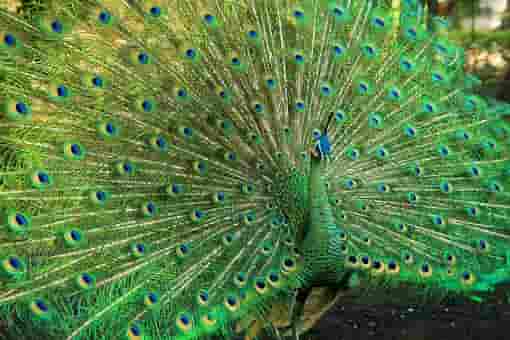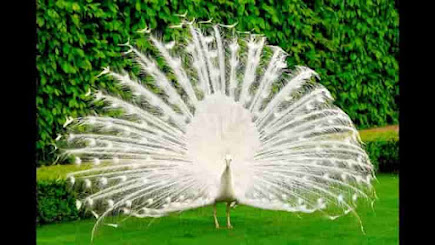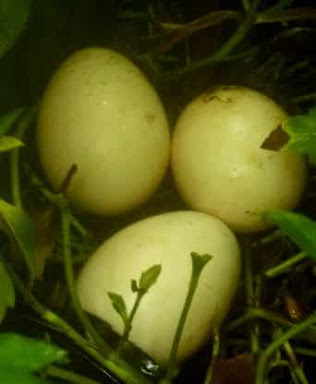Facts about Peacock

Peacock, commonly known as peafowl is a beautiful,
large, colorful bird. Male peafowl is called peacock and female peafowl is
called peahen and the babies are called peachicks. Both are also called
peacock. A group of peacocks is known as a muster or ostentation. There are three
species in the Phasianidae family, Indian peafowl or blue peafowl (Pavo
cristatus), Green peafowl (Pavo muticus) and Congo peafowl.
Description of Peacock

Peacock is one of the most attractive bird. This beautiful bird has magnificent plumage, a huge colorful tail, and a crest.
Indian peafowl or blue peafowl is an attractive and
beautiful bird. Among the
three species, Indian
peafowl or blue peafowl is the largest and heaviest. The length of male peafowl
or peacock is 100cm to 115cm from bill to the end of tail and body weight is 4
to 6kg.
Their train or
tail feathers are 150cm long and weight of their train is about 300gm. Peahens
are smaller than peacocks. Their length is around 95cm and weight is 2.75 to
4kg.
The male peacocks or male peafowls are metallic blue
in color, the feathers of their head are blue in color which are short and
curled. They have fan-shaped crest on the head that is made of feathers with
bare black shaft and tipped with bluish-green webbing.
The both sides of their head have greenish blue
feathers and have white patch around the eyes which are formed by bare white
skin. Their back is covered with scally bronze-green feathers with black and
copper markings.
The color of their tail is dark brown and has only 20 feathers. Their tail is also called train which is an iridescent arrangement of colorful feathers. The train is made up of more than 200 feathers which have an eye spot at the end of every feather, but some feathers have crescent shaped black tip at the end. The length of train of male peacock is 1m to 1.3m. The tail feather of a peacock can be 6feet long which makes up 60% of the bird's body length.
The peahen has
brown colored head and has a crest on their head but the tips of the crest are
chestnut edged with green. Their neck feathers are metallic green and breast is
dark brown glossed with green but the under part is white in color. They
produced sounds like pia-ow, may-awe, kok-kok or ka-aan. Peacocks have long and
strong greyish-brown legs with buff colored thighs and have a spur on the both
legs along the hind toes.

Green peafowl or green peacock is also known as Dragon
bird. The length of the male green peacock is up to 3m from bill to the end of
their train and their weight is up to 5kg. Peahen is 1.1m long and weight is up
to 1.2kg. Male peacock has iridescent metallic green colored plumage. Their
back, neck and mantle are covered with scaly green feathers. The shape of
their crest is different from blue peacock. Their
emerald green tail feathers have a series of eyes that are most commonly seen
when they are fanned. Peahen has dull grey-green feathers and has no train.
They have yellow crescent beside the ears and light blue patch under the eyes.
Congo peacocks are not as beautiful as blue peacocks.
Male peacock is 64cm to 70cm in length. They have metallic bluish-green
feathers, bare red neck, black tail with 14 feathers and grey feet. Their crest
is made with vertical white hair-like feathers. Peahen is 60cm to 63cm in
length and they have chestnut brown feathers with black abdomen. Their back has
metallic green feathers and chest has brown feathers.

White peacock is rare. Their white feathers result
from a genetic mutation. Their train has 150 feathers.
Habitat of Peacock

India and Sri Lanka are the homes Blue peacock and
Green peacock lives in Java and Myanmar. Congo peacock is found in Congo basin,
central Africa.
In India, peacock lives in south-east Indus River,
east Assam, Indian Peninsula, south Mizoram, Jammu and Kashmir and fully
protected under the Indian Wildlife Protection Act 1972. Blue peacock also
found in eastern Pakistan, Sri Lanka, and Bangladesh.
Green peacock
is found in the tropical, sub-tropical, evergreen and deciduous forests of
South-east Asia.
Congo peacock lives in Central Congolian lowland
forest of Congo. They are found in primary and secondary forest in Salonga
National Park located in the Congo River basin.
Peacocks are
found in bamboo, grasslands, savanna, scrub and farmland edge.
Diet of Peacock

Peacocks or peafowls are omnivores so they eat both
animal products and also plant products. Their favorite foods are small
snakes, small creatures like frogs, lizards, insects, ants, termites, locust,
leaves, fruits, vegetables, flower petals, seeds, grains etc.
Captive peacock eat cat food, cheese, nuts, cooked
rice, and many other supplemented food which has high protein.
Reproduction of Peacock
Peacocks or peafowls are polygynous which means that a
male peacock mates with several peahens in a season but in captivity, the green
peacock form monogamous pairs. Their breeding season starts in mid to late
spring. Male peacocks establish small territories, known as “leks”. During
their breeding season, male peacocks display their beautiful trains and
feathers to show their sexual and physical fitness to the peahens because the
peahens select their mate with large, colourful shiny train and feathers as a
mate. They display their courtship by spreading their iridescent train in a fan
shape and shake the feathers to produce a rattling noise for attracting peahen’s
attention. Then a peahen walks through the leks and examines the displays and
the feathers of the peacocks of the leks to select a mate. A male peacock breeds
with up to 5 to 6 peahens which is called harem.
Peacock Eggs and Peacock babies

During their
breeding season, a female peacock lays one or two clutches of eggs. The peahen scrapes
a hole in the ground to build her nest, which is hidden in the wood or leaves
and bushes. Sometimes they build the nest on the tree to protect their eggs and
chicks from predators. They lay an egg every other day which is 3 times larger
than hen’s egg. Each clutch contains 4 to 8 eggs and the colour of the eggs is
ivory or tan. After laying eggs, peahen sits on the eggs to hatch. When the
peahen sits on the first clutch, she does not lay the second clutch of eggs. This
time she leaves her nest only for collecting food. After 28 to 30 days, the
chicks come out of the eggs. The chicks are called peachicks. They are yellow
or brown in color and have feathers on their bodies. Then they do not know how
to eat food so their mother teaches her chicks. She picks a small piece of food
and drops it in front of the chicks, or she points it out with making a sound.
Sometimes she holds a piece of food in her beak and the chicks grab it from
their mother’s beak. Within two weeks, they able to forage food and fly. The chicks
stay with their mother about 7 to 9 weeks.
Threats to Peacock
Peacocks are threatened by extinction, smuggling,
hunting and poaching. The poachers kill the peacock for their beautiful
feathers and meat. Due to deforestation, peacocks do not get sufficient food,
breeding habitat, shelter and pushes them towards extinction. Due to mining, changes in agriculture and logging, Congo peacocks are threatened with habitat loss. As of
2013, Congo peacock was estimated 2500 to 9000 in the wild and they are listed
as vulnerable on the IUCN Red List. Green peacock is also considered to be
endangered. In 1995, their population in the wild was 5000 to 10,000.
Conservation of Peacock
Green peacocks are protected in some sanctuary and National parks including Baluran National Park in Java, Indonesia, Cat Tien National Park in Vietnam, and Kha Khaeng Wildlife Sanctuary in Thailand.
Congo peacocks are conserved in Salonga National Park
in Congo.
Peacock or peafowl is a large, beautiful and
attractive bird. In 1963, the peacock was declared the national bird of India.
Congo peacock is the national bird of the Democratic Republic of Congo. Peafowl
or peacock can live 10 to 25 years but in captivity, they can live 40 to 50
years. The peacock, a symbol of beauty,
wealth, immortality and pride, has always had a special place in the kingdom of
the beast.


.jpg)














0 Comentarios:
Post a Comment
Please do not use any abusing words or enter any spam links in the comment box